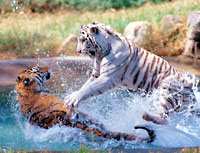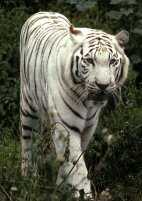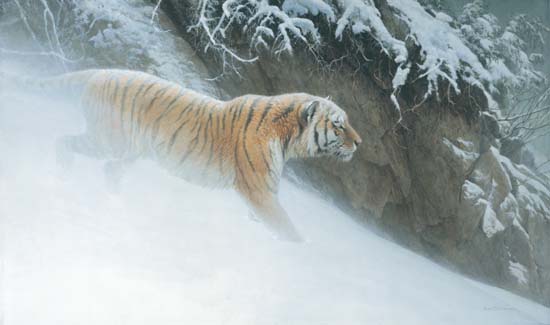|
THE
TIGER CLASSIFICATION GENERAL INFO SPECIAL FEATURES HABITAT DIET REPRODUCTION BODY SYSTEMS HUMAN IMPACT WEBLINKS SOURCES
| ||||
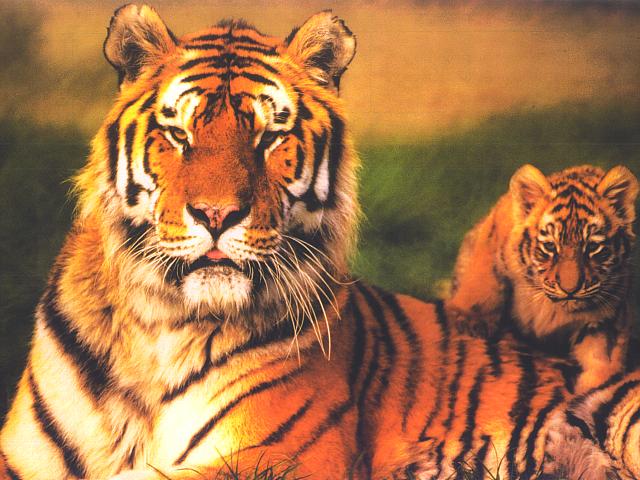
Kingdom: Animalia A tiger is a large mammal. The tiger is native to Asia. There are five different species of tigers: The Siberian, Indochinese, South China, Bengal, and the Sumatran. The Siberian Tiger is the biggest of all tigers and can grow to be 13 feet or more and can weigh 700lb. or more. The head-body length of a tiger is about 41/2 to 9 feet. The length of the tail is 3 to 4 feet. Tigers have round pupils and yellow irises. The white tigers have blue eyes. Tigers have sharp claws, which are retractable like domestic cats. Tiger scratches on trees are territorial indicators. Tigers can run up to 60 km/hr. They sleep about 16-18 hours a day. The Sumatran tiger has the most stripes of all the tiger subspecies and the Siberian tiger has the fewest. The life span of tigers in the wild is thought to be about 10 years; tigers in zoos live twice as long. REPRODUCTION |
GENERAL INFO: Tigers are vertebrate deuterstomes, their blastopore becomes their anus. They have a eucoelom and closed circulation. They have a endoskeleton and are endothermic (warm blooded), which means they have to keep a steady body temperature.
Tigers breathe with their lungs. They have a
2-loop circulatory system, closed circulation, with a 4 chambered heart. Tigers have a nervous system with a complex brain, which has an extremely
complex cerebrum. Their digestive system consists of a stomach,
liver, pancreas, small intestine, and a large intestine. Tigers
excrete urea as their nitrogen waste and their excretory system consists
of two kidneys. There is no one that exactly knows why tigers are striped, but scientist
think the stripes act as camouflage, and help tiger hide from their prey.
No two tigers have the same
pattern of stripes, just like human fingerprints. |
HABITAT:
Tigers live in
jungles, wood forests, rain forests, oak woods, tall grasslands, swamps,
and marshes. They use to live in Java, Bali, southern Asia, eastern
Turkey, to the eastern shores of Asia on the Okhotsk Sea, to the island of
Sumatra, and to the west of India. Now the tigers are not found west
of India or on the islands of Bali and Java. The remaining tigers
are in China, Russia's far east, and southern Asia. Tigers prefer to
stay in shadows and usually don't come onto open land. Tigers don't
live in South Dakota!
Tigers are carnivores. Tigers use their eyesight and hearing to catch prey. A tigers favorite prey is deer and a wild boar. Depending on where they live tigers can eat antelopes, buffalo, livestock, monkeys, fish, frogs, snakes, and young elephants and rhinos. They also eat fruit and berries. Tigers are an endangered species. 100 years ago
there were 8 different types of tigers (subspecies) - there were over
100,000 wild tigers living in the world. Today, there are only 5
tiger subspecies left and there are fewer than 7,000 tigers living in the
wild. The main threats to tigers are poaching, loss
of habitat, and population fragmentation. 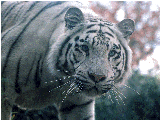
| ||
